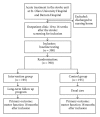A Long-Term Follow-Up Programme for Maintenance of Motor Function after Stroke: Protocol of the life after Stroke-The LAST Study
- PMID: 23227428
- PMCID: PMC3512328
- DOI: 10.1155/2012/392101
A Long-Term Follow-Up Programme for Maintenance of Motor Function after Stroke: Protocol of the life after Stroke-The LAST Study
Abstract
Background. There are no evidence-based strategies that have been shown to be superior in maintaining motor function for months to years after the stroke. The LAST study therefore intends to assess the effect of a long-term follow-up program for stroke patients compared to standard care on function, disability and health. Design. This is a prospective, multi-site randomised controlled trial, with blinded assessment 18 months after inclusion. A total of 390 patients will be recruited and randomised to a control group, receiving usual care, or to an intervention group 10 to 16 weeks after onset of stroke. Patients will be stratified according to stroke severity, age above 80, and recruitment site. The intervention group will receive monthly coaching on physical activity by a physiotherapist for 18 consecutive months after inclusion. Outcomes. The primary outcome is motor function (Motor Assessment Scale) 18 months after inclusion. Secondary outcomes are: dependency, balance, endurance, health-related quality of life, fatigue, anxiety and depression, cognitive function, burden on caregivers, and health costs. Adverse events and compliance to the intervention will be registered consecutively during follow-up.
References
-
- Stroke Unit Trialists’ Collaboration. Organised inpatient (stroke unit) care for stroke. Cochrane Database of Systematic Reviews. 2007;(4)CD000197 - PubMed
-
- Seenan P, Long M, Langhorne P. Stroke units in their natural habitat: systematic review of observational Studies. Stroke. 2007;38(6):1886–1892. - PubMed
-
- Langhorne P, Taylor G, Murray G, et al. Early supported discharge services for stroke patients: a meta-analysis of individual patients’ data. The Lancet. 2005;365(9458):501–506. - PubMed
-
- Langhorne P, Bernhardt J, Kwakkel G. Stroke rehabilitation. The Lancet. 2011;377(9778):1693–1702. - PubMed
-
- Lopez AD, Mathers CD, Ezzati M, Jamison DT, Murray CJ. Global and regional burden of disease and risk factors, 2001: systematic analysis of population health data. The Lancet. 2006;367(9524):1747–1757. - PubMed
LinkOut - more resources
Full Text Sources
Medical


